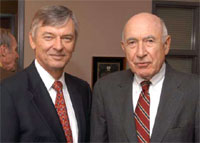Donald Steinwachs Installed as First Soper Professor (web article)
Drs. Don Steinwachs and Charles Flagle
(Photo credit: Larry Canner)
Donald Steinwachs says that, as he's gotten older, a new sense of urgency has overtaken his career-long quest to improve how health care is delivered: “I'd like to fix the health care system before I have to use it!”
Steinwachs, chair of the Department of Health Policy and Management, made the remark during his installation December 3 as the inaugural Fred and Julie Soper Professor of Health Policy and Management at the Johns Hopkins Bloomberg School of Public Health.
Charles Flagle, DrEng, professor emeritus of Health Policy and Management, introduced Steinwachs, saying, “Don came to the School of Engineering and could have chosen any field he wanted, from analyzing systems for the military to working to improve industrial operations—but he chose to work with the medical group at Hopkins.”
Steinwachs, PhD, MS, said that he liked math in school, but doubted he could thrive in the rarified atmosphere of pure mathematics, and so turned instead to system engineering—the endeavor to improve the efficiency and effectiveness of systems (a field Flagle describes as “decision-making under uncertainty”). Steinwachs wanted to apply a systems approach to health care delivery in an effort to pin down the best ways to improve medical effectiveness and patient outcomes.
Steinwachs defined his work as striving to translate clinical data and other evidence into information that is useful to policy makers. “My passion is to accelerate the translation and dissemination processes, so as to reduce the lag time between finding new evidence and making use of it to improve health care systems.”
Convinced from the start that “No one person or discipline alone can solve health care delivery problems,” Steinwachs said he was fortunate to join the School's faculty at a time when Dr. Malcolm Peterson, the first director of the School’s Health Services Research and Development Center, was trying to attract a multidisciplinary team. Steinwachs remembers being a little concerned, though, the first time he met with the multidisciplinary team, that no two people were speaking the same language. “But then I saw they were just using different words for the same things.”
Steinwachs also recalls that when his name first came up for promotion, he was turned down with the admonition that he publish more research papers. He now says that this experience made him empathize with those who get banged around by the promotions process. “I'm here to tell you,” he said, “you can get up and survive being bruised.” (Steinwachs now has more than 100 peer-reviewed journal articles under his belt.)
He gave heartfelt thanks to his family for their support, and also cited his faithful band of colleagues in Health Policy and Management—among them Pearl German, Barbara Starfield, Laura Morlock, Jonathan Weiner and Ellen MacKenzie—saying of his associates, “they largely shaped me and I hope I've reciprocated and helped them realize their potential too.”
Steinwachs, turning to the career of Fred Lowe Soper (1893–1977), wondered aloud if the renowned disease fighter might perhaps have had “the compulsiveness of an engineer. There was no such thing for him as No—you went out there and did it right.”
Dean Alfred Sommer also delivered an appreciation of Fred Soper, citing in particular the man’s tenacious, even ferocious, brand of public health field work—what a 2001 New Yorker profile (“The Mosquito Killer”) called his “fanaticism” and “absolutism” in the never-ending battle to save as many lives as possible.
One example Sommer gave of Soper’s doggedness: When in 1930 one of malaria's chief insect vectors, the Anopheles gambia mosquito, was discovered in Brazil for the first time, Soper immediately suggested killing all the mosquitos with salt water by opening that country's sea valves and flooding the coastal areas. This audacious plan was too radical for most, and so Soper was only called in to help after some 20,000 people had died of malaria. By that time, Soper’s task entailed purging A. gambia from some 180,000 square miles of territory—a job that Soper accomplished in a mere two years. —Rod Graham

